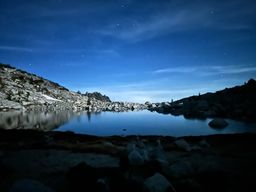Prusik Peak, West Ridge #
The backdrop #
For the last few years, after climbing some “alpine sport” routes and the west ridge of Forbidden Peak,Post-hoc trip reports to come at some point. I’ve wanted to acquire more skills in traditional lead climbing in order to “open up the alpine” so to speak. The iconic west ridge of Prusik Peak in the Enchantments had been at the top of my wish list for a long time. But a grueling approach and a competitive lottery system for camping means that most ascents are extremely long car-to-car efforts.I personally know two climbing partnerships that have been ruined by such an effort. For now, I had mentally committed to only climbing Prusik if I was able to camp nearby.
On March 17 this year, I groggily read an email titled “Enchantment Permit Area Advanced Lottery Lottery Results Announcement - Congratulations!” and found out that I had won a permit for four people to stay in the core zone of the Enchantments from July 4 - 7!True beginner’s luck: this was my first time applying for the lottery. Needless to say, the “race” was on: my mind instantly turned to Prusik and began taking stock of what needed to happen in the just-under-four months left to be comfortable climbing it. What followed was a fairly frenzied collection of small clinics, more multi-pitch climbs, and my first few trad leads.I might write that process up as a post of its own. Going into the trip, I was fairly confident that B, my friend Ian, and I could have a nice time on a beautiful alpine route.
The “approach” #
Of course, there’s a downside to the camping strategy: climbing gear, rope, sleeping gear, and food for 3-4 days meant that my backpack weighed in at around 54 pounds. Hiking up Asgard Pass (~2000 vertical feet in one mile) with that load was pretty, pretty, pretty tiring. We had planned on doing Prusik on July 5, our first full day up there, but decided that we needed a day with no alarms to recover from the hike in.Luckily, the weather was forecasted to be great for the entire trip.
We wound up having a quiet morning before taking a walk to tag Little Annapurna, which has a very high juice-to-squeeze ratio: with a bit of low-angle walkingAnd a couple of small snow-fields at this time of year., we were rewarded with views that exceeded expectations and were back in camp very early still.
The day “began” when B got out of the tent at 2am for a pee break. I had brought a small and light tripod with me, hoping to do a little bit of night-time photography. Although I didn’t carve out a dedicated time for this, the shots I was able to capture just from leaning out the tent for a couple of minutes in the middle of the night were pretty mesmerizing. Hard to beat a shooting star and aurora borealis over a lake as a view from your “bedroom”.
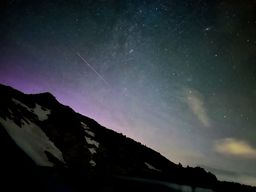
The approach #
Because of our somewhat-late arrival on our first night, we decided to set up base camp at an unnamed tarn one tier down from Isolation Lake (the first big lake when you get into the core zone above Asgard Pass). This was a lovely spot: easy water access, not too many bugs, and just below a snowfield that goats loved to use both for transportation and play. But it did mean that we had an approach of almost 2 miles with a little bit of elevation gain.
With a relatively-short approach and also a “short” climb, we started walking at the luxurious hour of 9am,I’m realizing now that it’s been awhile since I’ve had a real alpine start. Getting old? Or just wise? saying goodbye to the fourth person in our party, who was heading out of the zone entirely that day. The first 3/4 of the approach was smooth sailing: some elevation loss, including a fun 100ft glisade section, and then a nice and easy romp up to Prusik Pass. From there, we made the mistake of going up and over the first bump, instead of around it, which definitely slowed us down a bit. After that extra bit of scrambling, we eventually refound the main approach path, scrambled up one more knob, and found ourselves at an overhanging rock at the base of the route. 'Twas a perfect place to stash big bags and gear up for the route.
The climb #
The route starts with a long first pitch, accentuated by a wide crack (5.6ish) in an unusually white section of rock (see below). It was quite cruisy climbing through this section, which was a nice way to calm a few nerves that arose since this was some of my first alpine trad leading. From here, the beta we had said to continue “through blocky climbing to the West Ridge. Belay when the ridge levels out or when you hit a flat trail.” The climbing was certainly blocky enough, but it was hard to tell what the flat trail was and/or when the ridge leveled out. One section here was especially opaque to me; after going back and forth between a couple of options, I committed to just wrestling to the top of an awkward off-width with a flaring lip. Eventually, I saw a rappel station (a lot of tat around a block) at the top of a beautiful swooping flared crack and headed for that. I secured myself, almost using the full 60m of our shorter ropeB was on my 70m 8.6, and Ian on his 60m 8.0., and belayed both B and Ian up.
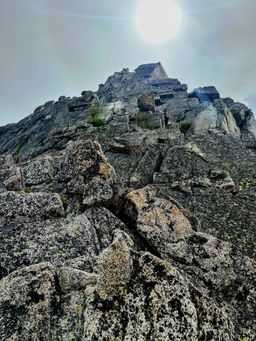
Pitch 2 began with a short burly roof pull after a stemming corner.I remembered seeing photos of this little section in one other trip report, so that made me feel better about the anchor choice as well. Actually: it began with me pausing in the corner after placing my first piece while Ian and B tried to undo the mistakes of some horrible rope management on my part. After that, a couple of traverses and downclimbs put me on what clearly was a trail. I think the intention was to traverse left on a slab at the base of the flaring crack that leads to the tat anchor we used. One more face section led back to the ridge proper, at which point I did the “air step” across from one boulder on to another. A quick slab section led to two major horns that were easy to sling for an anchor. Looking back at this pitch (see below), the ropes almost look like a zip line at the start of the pitch, with so much up-and-down wandering there.
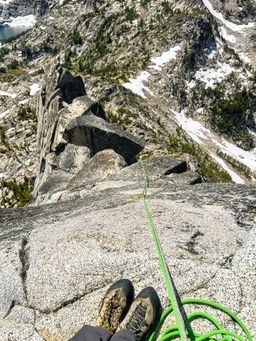
Pitch 3 begins with the crux slab. After clipping one very old piton and placing a backup micro-cam, there’s about 20 feet of 5.7 slab climbing that ends in a glory jug. Unfortunately, we didn’t take any pictures of this section, but they aren’t hard to find anywhere online.My one regret of the day was that we as a group did not take that many photos on the route itself.
After placing the back-up protection, I committed to the crux and flew up it fairly quickly. Although it’s a bit mentally committing, there are great feet the whole way through, and the arete is also positive in lots of places, so it really was not too bad of a section. After topping out the slab, the pitch turns into a long, wandery, traverse-y one. One tip-toes around the famous large boulder on top of the ridge (see Ian and B below), after which there’s an even more exposed bloc that one either tip-toes around or passes with an au-cheval move.
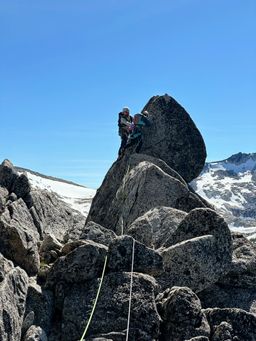
From there, it’s mostly walking on a flat grassy section to get to a nice ledge system to set up an anchor. After playing around to find three good pieces of pro for the anchor (a slung horn, one green cam, and a nut), I was happy to apply a technique I’d recently learned from the great Adam Butterfield in a clinic: girth hitching a biner to create the master point when your soft material isn’t long enough to tie into a knot itself. It felt good to apply a technique recently learned in ground school “in the wild” so to speak. One small note on pitch 3: with the long traverse-y section, there was some pretty bad, but probably unavoidable, rope drag. The ony other option would be to break it up into two pitches; choose your own adventure there.
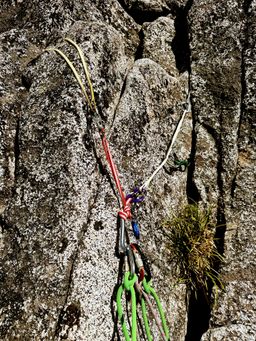
We knew that pitch 4 had two variations: a 5.6 off-width and a 5.8 finger-crack. I opted for the latter since it looked like more “normal” climbing and I do not exactly have a lot of off-width technique dialed. Thirty to fourty feet of very easy climbing led to a nice stance at the base of this finger crack, which has a ramp shape (ending vertically) and an “open book” corner vibe.
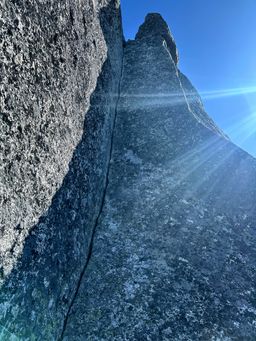
I decided to climb it in a mix of crack and compression styles, using the right arete and mostly smearing the face for feet (with the occasional little feature to help as well). After placing two pieces, I was just getting ready to put in a third when the small feature my left foot was on broke and sent me flying.Maybe it would have been wiser to stem the corner and use the crack more instead? Who knows. Luckily, the #0.2 I had placed 5-6 feet below held perfectly and it felt like a normal sport climbing fall. Nevertheless: the final pitch of Prusik felt like a hell of a place for my first trad lead fall. After a short moment hanging there, I pulled back on, climbed above that same piece, put in one more piece (a micro-cam), and then climbed very quickly for the top of the crack, which was a lip jug that was easy to pull up and over on.
From there, there’s some fun climbing around a corner on to one more ledge. There’s one random bolt when you pull the lip; I clipped into it, but even with a long extended alpine draw, I down-climbed and unclipped that bolt because of heinous rope drag. At that point, the only thing between you and the summit are two chimneys. I pulled out a print-out of Nikkin Fumki’s beautiful painted topo of the routeI also ordered prints for myself, Ian, and B after we got home. and was happy to see that it said to take the left chimney. It also says to go “through the hole to be birthed to the summit”. As cool as that sounded, it looked really claustrophobic. After some wrestling (and annoyance with my small pack getting in the way), I was happy to find that the right side of the chimney had some huge jugs on the side/top, so was then able to pull up and over on to the summit!
What followed might have been my actual crux: even though I was able to take my climbing shoes off at a comfortable belay station, the rope drag was heinous, the sun was baking, and I was being eaten alive by mosquitos. My left forearm started cramping as I was pulling the ropes up, since it had had enough of that motion throughout the day. All worth it though: Ian and B cruised up the pitch and joined me on top for a proud summit selife.
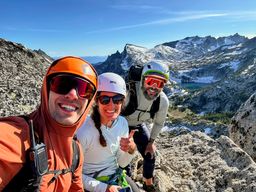
The descent and return #
Two double-lengths and one single rappel got us back to terra firma fairly quickly. Starting the first rap is a little awkward, squeezing into a little chute, but then is smooth sailing. The rope did get stuck when we were pulling after the first one. Luckily, my micro-traxion came to the rescue and we were able to use its progress capture to put enough pressure on the rope to get it unstuck. This was actually the second time in as many weeks that this trick came in handy and saved us from having to ascend the rope to get it free. I’m never climbing a multipitch without one now!
It was mostly smooth sailing from then on out. Easy return to our gear stash and to Prusik Pass (no problem finding the trail around the first bump from this direction). The sun was starting to set, which treated us to some glorious views on the hike out.
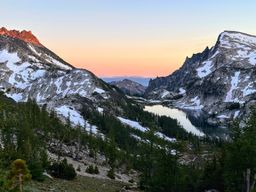
I’m a sucker for lake reflection shots, and Inspiration did not disappoint. This was just before walking up the section we glisaded down, which also would put us mostly back at the elevation of our camp and mark the transition to the much-needed “final stretch” home.
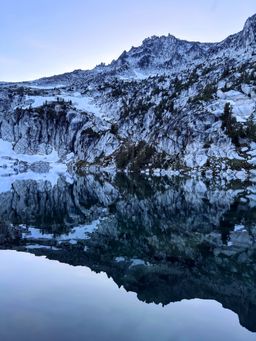
After that short climb section, we turned around for our last looks at Prusik and the route we had just climbed. It’s always such a satisfying feeling to look at a route and say “we were just there”. Especially one like this that’s relatively hard to get to and that most people only see in photos.
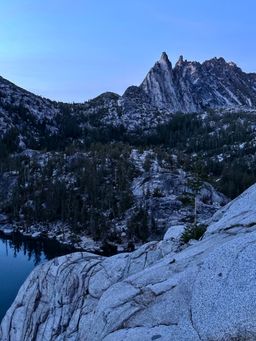
We returned to camp just before 10pm, making a 13hr camp-to-camp day,We were definitely slow as a team of 3, especially with getting lost on the way in, but so it goes. and found an absolute treat: our fourth person’s partner had come up to meet them and left two Rainier beers and a flask of whisky for us at camp. I’m no stranger to the post-exertion beer,The car beer after a ski tour is probably my favorite. but this one might be the single best sip I’ve ever had, especially when you combine the setting, the surprise factor, and everything else that went in to the day.
Luckily, the weather was perfect at that hour, after high winds the previous night sent us in to our tents at 8pm. We enjoyed our refreshments and nice hot rehydrated meal as we watched the sun set and the stars rise. Definitely a day to remember.
